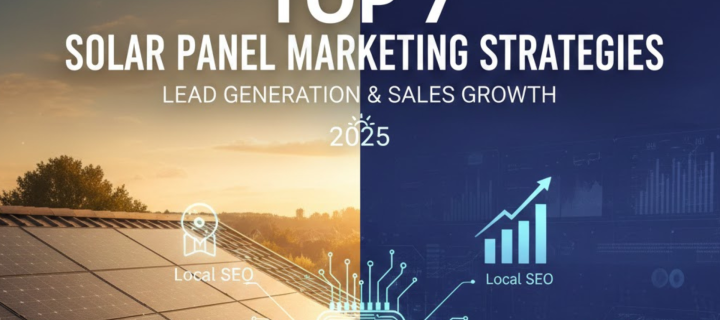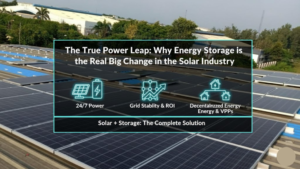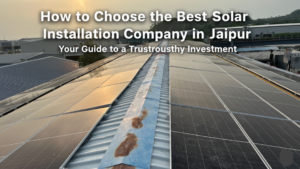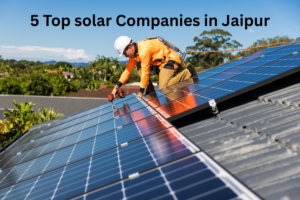The solar industry is experiencing unprecedented growth, yet the competition for quality leads is fiercer than ever. As consumer interest shifts from simple awareness to actively seeking installation, the strategies used by successful solar companies must evolve beyond generic advertising.To achieve robust lead generation and substantial sales growth in 2025, your approach needs to be strategic, trust-focused, and deeply integrated with how homeowners and commercial clients make purchasing decisions.Here are the 7 most effective Solar Panel Marketing Strategies designed to position your company as the local authority and drive exponential business success.
1.Solar Panel Marketing Strategies for Local SEO Mastery (The Proximity Advantage)

For a high-value, geographically specific service like solar installation, Local SEO is not just an option—it is the foundation of your lead generation strategy. Potential customers almost always choose an installer they perceive as local, trustworthy, and highly-rated.
In-Depth Sub-Strategies:
- Google Business Profile (GBP) Optimization: This is your #1 local asset. Go beyond basic setup:
- NAP Consistency: Ensure your Name, Address, and Phone Number (NAP) are identical across all online platforms (website, directories, social media).
- Service Area Precision: Clearly define your service radius, and use the “Services” section to list specific offerings (e.g., Residential Solar, Commercial Solar, Battery Storage, Maintenance).
- Post and Q&A Engagement: Use GBP Posts for weekly updates on special offers. Actively answer questions in the Q&A section to address common customer concerns upfront.
- Targeted Local Content: Create blog content that specifically answers localized questions.
- Structured Data (Schema Markup): Implement LocalBusiness Schema markup on your website to explicitly tell search engines you are a local service provider, boosting your visibility in the “Snack Pack” (Google Maps results).
- Proactive Review Generation: Reviews are the lifeblood of Local SEO. Implement an automated system to request reviews immediately after a successful installation. Respond to all reviews—positive and negative—to show excellent customer service.
| Review Count | Local SEO Impact | Recommended Tool Action |
| 0 – 25 | Low trust factor, minimal ranking boost. | Implement automated email follow-ups. |
| 25 – 100 | Good local trust, ranking starts improving. | Directly ask satisfied customers via text message. |
| 100+ | High authority, strong local visibility (Snack Pack). | Integrate review requests into the final invoice/sign-off process. |
2.Solar Panel Marketing Strategies Using Video to Build Trust and Transparency

Solar is an expensive, complex, and long-term investment. Customers naturally harbor skepticism. Video marketing is the most effective medium to cut through that doubt and humanize your brand.
In-Depth Sub-Strategies for Effective Solar Panel Marketing Strategies
- Behind-the-Scenes & Installation Process Videos: Film short, professional videos showing your team at work. Highlight safety procedures, the quality of materials, and the care taken during installation. This demystifies the process and builds faith in your professionalism.
- Client Testimonials with Substance: Go beyond simple “I love my panels.” Capture videos where clients discuss:
- Their initial skepticism and how you overcame it.
- The exact savings they are seeing (specific numbers build trust).
- Their experience with your sales and installation teams.
- Educational Webinars & FAQs: Host monthly webinars (and record them for YouTube/website) covering topics like “Understanding Your Solar ROI“ or “Comparing Different Battery Storage Options.” These establish your technical authority and generate qualified leads via registration.
- The “Meet the Team” Series: Introduce your sales reps, engineers, and installers. People buy from people they like and trust. Showing the faces behind the brand significantly lowers the perceived risk of the purchase.
3. Solar Panel Marketing Strategies with High-Incentive Referral Programs

Word-of-mouth (WOM) remains the highest-converting lead source in solar. A formalized, generous referral program moves WOM from a random occurrence to a predictable, scalable marketing channel.
In-Depth Sub-Strategies:
- The Dual-Sided Approach: A true referral program rewards both parties:
- The Referrer: Offer a significant cash bonus or a gift certificate for every successful installation.
- The Referred Client: Offer a substantial discount (
- Automated Communication: Use CRM tools to automatically enroll all past customers in the program. Send quarterly reminders detailing how much they could earn and providing easy-to-share links or personalized referral codes.
- Tiered Incentives: Encourage frequent referrals by creating tiers. After 3 successful referrals, the client might move to a “Gold Tier” with a higher bonus amount per lead. This gamifies the process and maintains engagement.
- Non-Customer Referral Partnerships: Expand the program beyond past clients. Target related professionals (Roofers, HVAC companies, Real Estate Agents) who encounter homeowners with high energy needs daily, offering them a fair commission structure for qualified leads.
4. Develop Irresistible Lead Magnets Focused on Financial Metrics (The Value Exchange)

The decision to go solar is primarily financial. Generic lead magnets (like “Our Brochure”) are ineffective. You must offer immediate, personalized financial value in exchange for contact information.
High-Converting Lead Magnet Ideas for PowerfulSolar Panel Marketing Strategies
- The Hyper-Specific Calculator: Create a custom-built, interactive tool embedded on your website that asks for monthly electricity bill, zip code, and roof size, then instantly outputs an estimated “5-Year Savings Projection.”
- Localized Incentive Guides: Annually update and gate a downloadable PDF titled: “The Complete 2025 Guide to Solar Tax Credits, Rebates, and Local Incentives in [Your State].”
- The “Free Home Energy Audit” Package: Position this consultation as a high-value, no-obligation service. Promote it with an estimated monetary value Conversion Optimization for Landing Pages: Ensure the landing page for your lead magnet:
- Has minimal navigation (no distractions).
- Uses a simple, short form (Name, Email, Zip Code—that’s all you need initially).
- Clearly states the value proposition and the privacy policy.
5. Master Targeted Paid Advertising (PPC) with Intent-Driven Keywords

While Organic SEO takes time, Pay-Per-Click (PPC) allows you to capture high-intent leads immediately. Wasting ad spend on broad terms is common; precision is key.
In-Depth Sub-Strategies:
- High-Intent Google Search Ads: Bid aggressively on keywords that indicate immediate intent:
- Examples: “solar installation companies near me,” “cost to install solar panels in [city],” or “solar installers with battery storage.”
- Use Negative Keywords (e.g., ‘free,’ ‘DIY,’ ‘school project’) to prevent irrelevant clicks.
- Geographically and Demographically Targeted Social Ads (Facebook/Instagram):
- Target homeowners in areas with high utility costs or recent rate hikes.
- Focus on Lookalike Audiences based on your existing customer list.
- Aggressive Retargeting Campaigns: Less than 5% of first-time visitors convert. Set up retargeting ads that display personalized messaging to users who visited your savings calculator or pricing page but did not fill out the form. Offer a final incentive to convert them.
- Call-Only Ads: For urgent, high-intent searches on mobile devices, use Google’s Call-Only Ads, ensuring every click results in a direct phone call to your sales team.
6. Implement a Multi-Channel Follow-Up and Nurturing Sequence

A lead is only the starting point. The vast majority of solar leads require extended nurturing before they convert. A strong, automated follow-up sequence is non-negotiable.
In-Depth Sub-Strategies:
- The 7-Touch Rule (Initial Phase): Ensure your sales team has a clear protocol to contact a new lead within 5 minutes of form submission, followed by a sequence of 7 touchpoints (call, email, text, personalized video message) over the next two weeks.
- Segmented Email Nurturing: Segment your leads based on their stage of readiness:
- Top of Funnel (Curious): Send educational content, FAQs, and general savings articles.
- Middle of Funnel (Evaluating): Send competitor comparisons, detailed ROI analysis, and case studies.
- Bottom of Funnel (Ready to Buy): Send a specific, time-bound offer and direct links to book a consultation.
- Personalized Video Messages (BombBomb/Loom): Have the sales representative record a short (30-second) personalized video saying, “Hi [Lead Name], I saw you downloaded our Guide to Incentives. My name is John, and I’m here to answer any specific questions you have about your home.” This dramatically increases response rates.
7. Strategic Partnerships and Alliances for Warm Lead Feeds

Generating leads through your own efforts is crucial, but tapping into a partner’s established customer base can provide an immediate flow of high-quality, pre-qualified leads.
In-Depth Sub-Strategies:
- HVAC and Home Services Partnerships: HVAC companies service high-energy-consuming homes and have a built-in trust factor. Establish a reciprocal referral agreement where they refer solar leads for a commission, and you refer AC maintenance/replacement.
- Real Estate Agent Relationships: Offer a referral fee to local real estate agents. When a client buys a home, the agent is already the trusted advisor and can introduce your solar upgrade services during the closing process.
- Community and HOA Engagement: Sponsor local events, give presentations at Homeowners Association (HOA) meetings about the benefits of solar and navigating permits, or partner with local credit unions for solar-specific financing options.
Frequently Asked Questions (FAQ) about Solar Marketing
- What is the most cost-effective solar marketing strategy?
- Referral marketing and Local SEO are the most cost-effective strategies, as they rely on satisfied customers and organic search presence, requiring minimal advertising spend.
- How long does it take to see results from solar SEO?
- While you may see initial results from Local SEO (GBP) in 2–4 weeks, significant growth from comprehensive content marketing and organic SEO typically takes 6 to 12 months of consistent effort.
- Should my solar company focus on Facebook or Google Ads?
- Focus on Google Search Ads for high-intent, immediate conversions (people actively searching for installers), and Facebook Ads for lead generation and brand awareness among specific demographic groups (homeowners in target zip codes).
- How technical should a lead magnet be?
- The lead magnet itself should be easy to digest but offer personalized financial value, such as savings estimates. Save the highly technical product comparisons for the middle of your email nurturing sequence.
Conclusion: Act Now for 2025 Growth
The key to mastering Solar Panel Marketing Strategies in 2025 is moving beyond outdated print ads and cold calling. Success demands a digitally integrated approach that prioritizes Local Authority, Transparency (via Video), Financial Value (via Lead Magnets), and Trust (via Reviews and Referrals).
By rigorously implementing these seven strategies—from optimizing your GBP to leveraging high-incentive referral programs—you will not just compete, but genuinely dominate your local market, securing high-quality leads and achieving sustainable sales growth for years to come.








